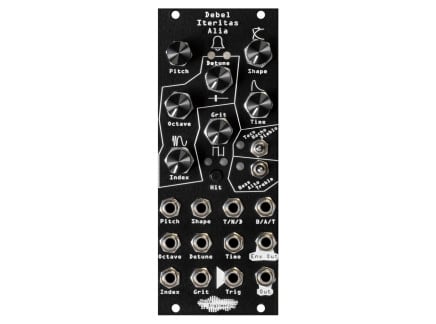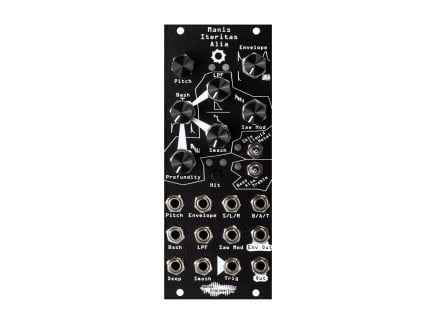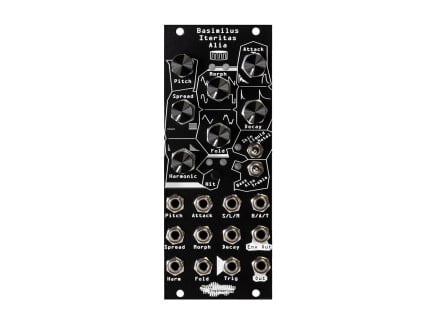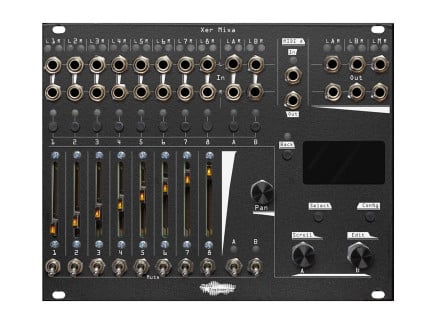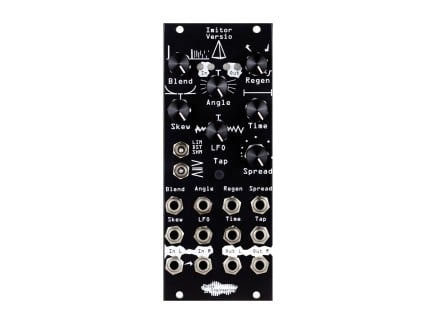Earlier in 2023, we were met with surprising news from Noise Engineering: they were discontinuing most of their Iteritas series Eurorack modules. This came as something of a shock—it's safe to say that these are among the best-selling and best-loved Eurorack modules at Perfect Circuit, and on the whole. However, as with any company working in the niche corners of the already niche field of electronic musical instrument design, Noise Engineering was faced with supply chain complications and, eventually, the XMOS CPU used in these modules was discontinued. As they have said...that's a reasonably compelling reason to reassess a product.
Basimilus, Manis, Cursus, and Ataraxic Iteritas—all discontinued in this sweep—were no doubt some of the most influential Eurorack modules available. They define the sounds of countless sytems, and their extreme level of modulate-ability (CV inputs for dang near everything) even created, from our perspective, their own patching style. With any of these modules, if you could patch a sufficient number of CV signals into them simultaneously, you'd get a surprisingly dynamic range of evolving sounds. Often, this would push them into territory that transcended their roles as individual sound sources. The right set of sequences going into a Manis Iteritas could turn it into a terraced set of interlocking contrapuntal melodies; the right combination of triggers and random voltages into Basimilus could turn this single percussive voice into an entire electronic drum kit, from punchy kicks to screaming metallic textures. Their discontinuation brought with it a certain air of sadness—and a curiosity about what might come next.
Happily, we didn't have to wait long for an answer: Noise Engineering has just announced the Alia platform. The newest members of their lineup of modules utilize this platform to pick up exactly where the Iteritas family left off...and we now have replacements for Basimilus Iteritas Alter in the form of Basimilus Iteritas Alia, and for Manis Iteritas in the form of Manis Iteritas Alia. Additionally, we welcome a new member of the family: Debel Iteritas Alia, which brings all-new capabilities to their lineup.
But...what the heck do we mean by platform anyway? And how do these new modules stack up to their prior offerings? Read on to find out.
Noise Engineering Loves a Platform
I personally remember discussions with Noise Engineering's Kris Kaiser and Stephen McCaul upon the release of Manis Iteritas in 2017. They made it clear that Manis was an outgrowth of their previous work on Basimilus Iteritas Alter, and that the two not only shared a very similar synthesis structure, but also a nearly identical layout in terms of front-panel jacks and controls. A friend and I asked if it would be possible for the Manis firmware to run on the BIA hardware—but they mentioned that, while that ability could certainly streamline their production process, the hardware was actually different, and that it wouldn't be possible to translate directly between these two modules.
The ensuing years brought several other modules that used very similar hardware layouts with distinct code...namely, Cursus Iteritas and Ataraxic Iteritas. In the background, we wondered if they were moving forward with the idea of consolidating their hardware into a dedicated "platform" for module development.
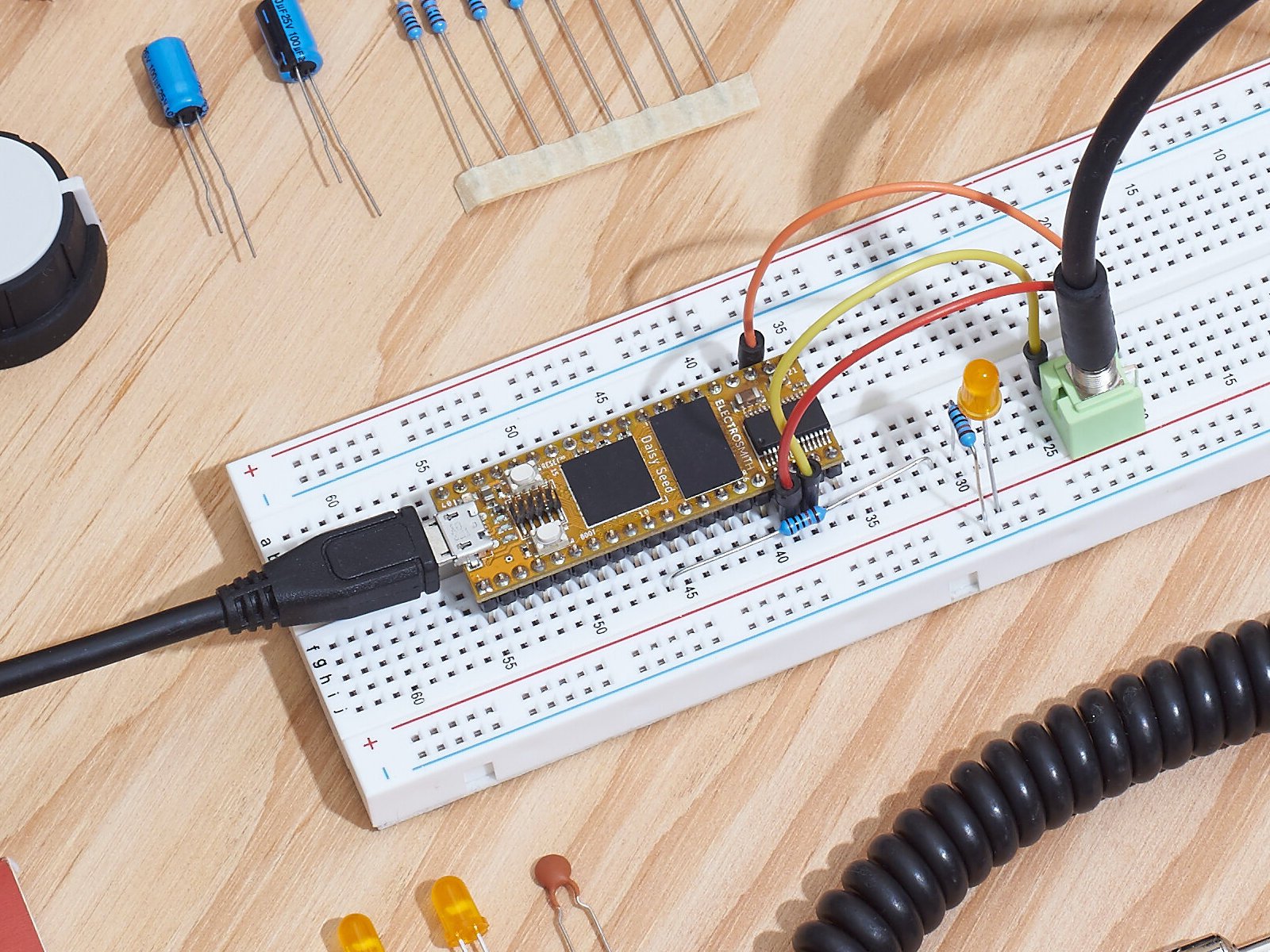
[Above: an Electrosmith Daisy Seed, the DSP platform on which Noise Engineering's Alia, Versio, and Legio platforms are based. Image via Electrosmith's website.]
With the introduction of the Electrosmith Daisy (recently discussed in an interview with Qu-Bit's Andrew Ikenberry), things changed for Noise Engineering and a number of other modular manufacturers. For those not familiar, Daisy is a small DSP platform designed specifically for the development of electronic musical instruments. It's more than just a simple CPU: it's a streamlined piece of hardware fine-tuned to account for many of the unique software and hardware requirements of digital musical instruments. Its easy availability and streamlined workflow have made it possible not only for new makers to enter the sphere of hardware production...but they have also refined the workflows of established manufacturers. If you look on the back of new modules from Qu-Bit, Modbap, Blukaç, Venus Instruments, and others, you're likely to find a Daisy.
One of the first manufacturers to fully embrace Daisy's ease of platform-ification, though? Yep, it was Noise Engineering. Previously, they had been working on internally developing their own general-purpose platform for internal use, called George (after their delightfully sweet and now sadly departed dog of the same name—RIP George, we love you). However, upon learning about Electrosmith's development of Daisy, they dropped development of the George platform and went all-in with Daisy. The world was first introduced to Desmodus Versio at NAMM 2020, alongside an early predecessor of Virt Iter Legio called Virt Iter. They confirmed that these weren't just new modules: they were platforms designed to have alternate firmwares installed. Right out the gate, they confirmed that they would release new firmwares for free, and that it would even be possible for users to develop their own firmware.
And indeed, Noise Engineering has treated Versio and Legio as platforms. Demodus Versio was released in August of 2020, with the first alternate firmwares released only months later. Eventually, Virt Iter evolved into the current Virt Iter Legio—for which several alternate firmwares are also available. You can purchase several Legio and Versio modules with distinct faceplates, but all Versio modules are compatible with one another's firmware, as are the Legio modules. While Versio is focused on stereo effect processing, Legio is focused on sound generation and other simple, less UI-intensive tasks. So, if you buy even a single Versio or Legio module, you're not just buying what's on the front panel: you're buying into a wealth of opportunities for creative sound sculpting, all accessible at a moment's notice (provided that you have a USB cable at the ready).
Today, we meet a third distinct platform: Alia, designed specifically for more complex multi-parametric sound generation duties. As with Legio and Versio, the Alia platform is based on the Daisy, and allows users to easily swap firmware for free. It is open to user development, and Noise Engineering will continue to develop their own fresh new Alia code...allowing you to transform your modules at will. That in mind, let's take a closer look at the first three offerings from the Alia series: Basimilus Iteritas Alia, Manis Iteritas Alia, and Debel Iteritas Alia.
Read Alia 'bout It
Let's start by taking a look at some of the more familiar members of the Alia family: Basimilus Iteritas Alia and Manis Iteritas Alia (which, for the sake of my wrists, I'm just going to type as BIA and MIA going forward...I really ought to try out an ergonomic keyboard).
BIA and MIA are nearly 1:1 translations of their predecessors, with a handful of differences. Noise Engineering worked hard to ensure that the new modules would sound as close as possible to the originals—so, with a couple of edge cases aside, they should perform exactly as you'd expect based on experience with the older versions, and they'll certainly mesh sonically with their forebears. Functionally, there are some notable differences: pitch CV inputs on Alia have a range of -2V to +5V; Alia modules feature an envelope output that mimics the envelope shape of the internal synthesis engine for use as a modulation source in your system; and happily, the Alia platform automatically calibrates its 1V/oct inputs upon powerup. Additionally, it's worth noting that Alia modules use the pitch encoder system first seen on Manis Iteritas: the pitch encoder can be turned for fine tuning adjustments, or pressed and turned for coarser adjustments.
Those details aside, let's discuss what the individual modules do.
Basimilus Iteritas Alia: a Universal Digital Drum Synthesizer
BIA is an all-in-one module designed for the creation of all sorts of percussive sounds, leads, and bass tones. It uses a six-oscillator additive/FM structure, parameterized to privilege the production of percussive tones. The Harm and Spread controls alter the level and frequency of the additive oscillators; the Morph control continuously alters their waveform, for everything from soft sines and triangles to intense saw and square tones. The Fold parameter adds wavefolding and distortion for even more aggressive tones. The attack control can be used to add noise to the sound or decrease the forcefulness of the sonic impact; decay controls how long sounds ring after receiving an incoming trigger (or pressing the Hit button).
The mode switch is used to alter the structure of the internal synthesis algorithm, with a choice of Skin, Liquid, and Metal modes. Skin is ideal for snares, hits, and melodic sounds. Liquid is identical to Skin, but uses a pitch envelope—making it better for kicks, toms, or other percussive tones that rely on a pitch contour. Metal adds some FM to the equation, ideal for zaps, hats, and more. Additionally, it's worth noting that the mode selection can be modulated—so it's possible to use your sequencer, random voltage sources, or any other CV source to change modes on the fly.
Again, that's one of the original BIA and the new BIA's strengths: by providing CV inputs for literally every parameter, you can cause the module to shift its sonic role constantly. Use a multi-track CV or gate sequencer to mix things up on a step-by-step basis, or plug in some random voltages to hear it evolve over time...no matter what you throw into those inputs, you're going to get something wild at the output.
Manis Iteritas Alia: an Aggressive Industrial Percussion/Synth Voice
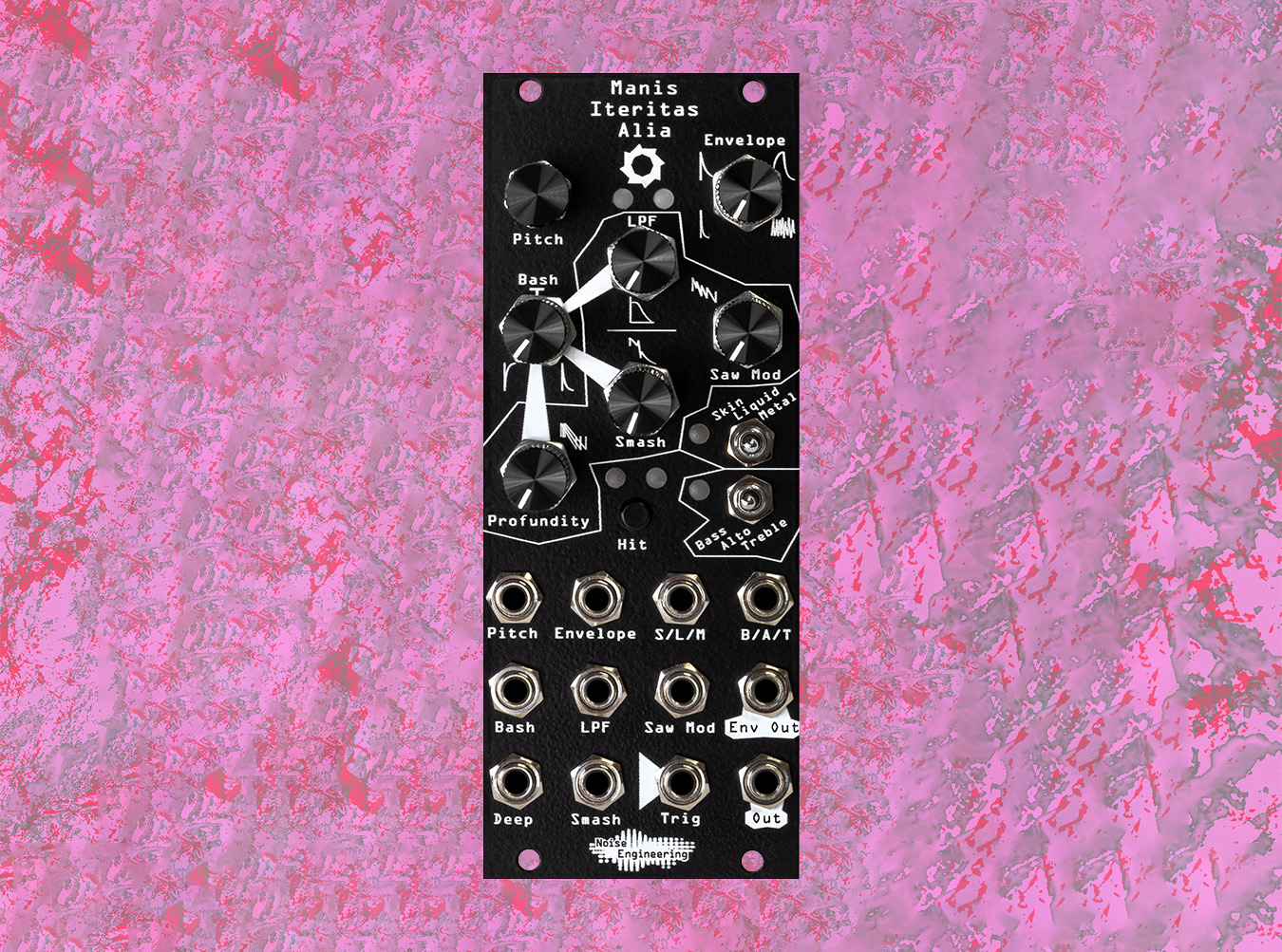
MIA follows suit; it's a similarly flexible sound source fine-tuned for dark, industrial tones. It offers a slightly more aggressive take on BIA's sound structure—using saw waves and a number of additional waveshaping/sound alteration tricks for everything from trancey super saw-esque tones to grinding industrial bass lines. The Saw Mod offers hard sync and PWM-like tones; Profundity adds additional oscillators for a detuned, chorusing effect. Smash provides additional distortion, and Bash uses the internal envelope to modulate the internal lowpass filter, Profundity, and Smash controls all at once.
Like BIA, if offers Skin, Liquid, and Metal modes, each of which take on new life due to the differences in the internal sound structure. The single envelope parameter alters the duration of the decay envelope, and at maximum, turns MIA into a free-running oscillator that you can use with external filters, VCAs, and more.
Debel Iteritas Alia: Hybrid Additive Phase-Modulation Voice Crunch Supreme
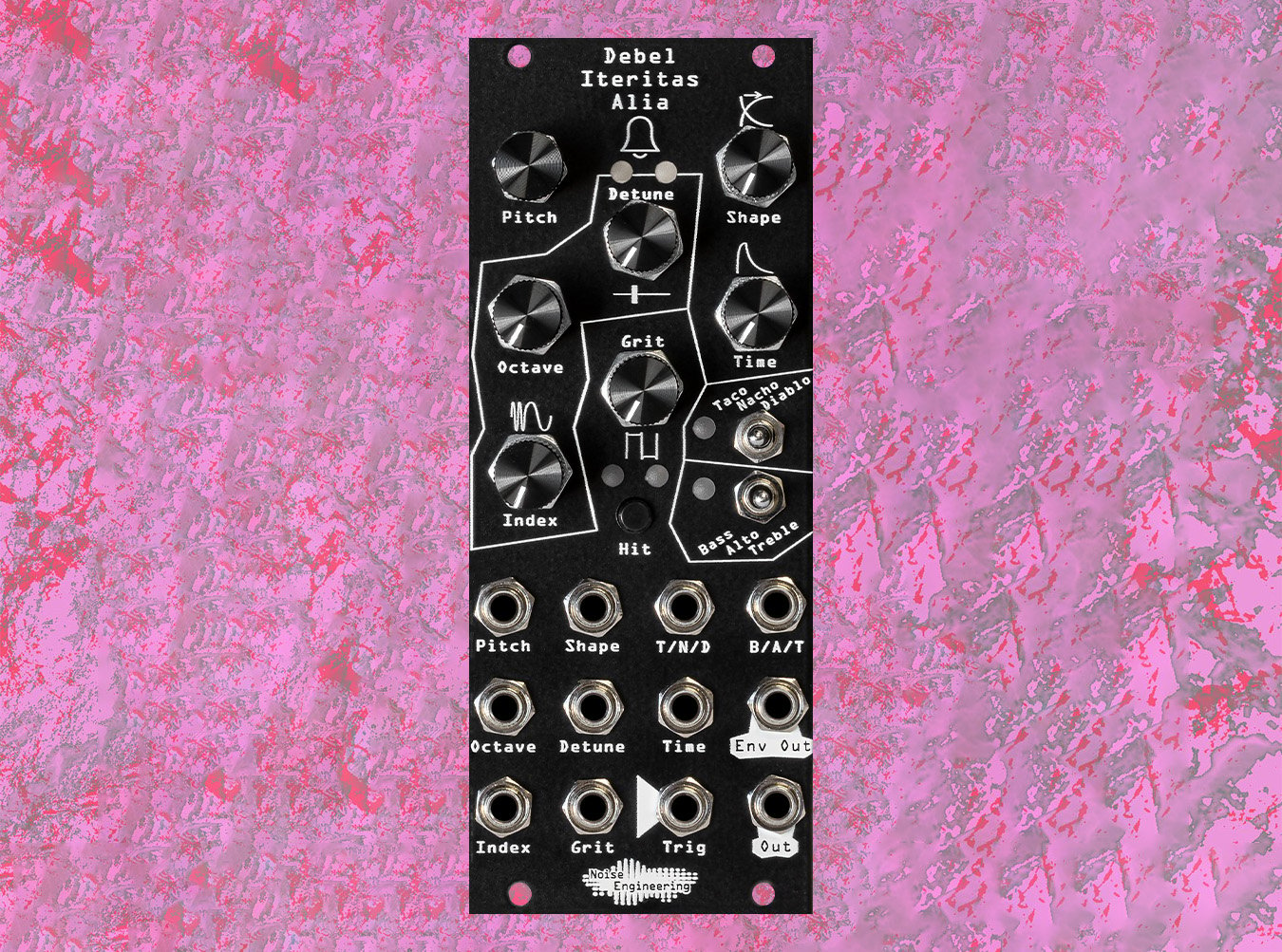
The newest addition to the lineup, though, is Debel Iteritas Alia. And yes, that's Debel as in, da Bell. DIA is a hybrid additive/phase modulation voice tailored for the creation of FM plucks, ambient tones, and bell-like sounds that just might remind you of the DX7's role in the creation of a certain fast food chain's sonic logo. It takes the Iteritas family into new sonic territory, and frankly, it's a downright Baja Blast, y'all.***
Despite being based around the notoriously complex technique of phase modulation (better known to mere mortals as Frequency Modulation Synthesis), DIA is parameterized in such a way that you can freely explore. This isn't going to be like programming a DX7: you can instead simply turn knobs, flick switches, and CV to your heart's content. It's playable, performable, and allows for easy exploration of classic electronic music tones. Use it as a melodic voice, an experimental texture generator, or yet another sound source for your percussive techno system.
DIA uses a four-operator structure arranged to equally accommodate phase modulation and simple additive techniques. Each of its algorithms (Taco/Nacho/Diablo) use four operators, each of which use four oscillators to define their current additive waveshape. In Taco mode, you get a 2x2 algorithm; in Nacho, you get a linear four-operator structure with each operator modulating the next in series. Diablo mode takes Nacho a step further, adding a pitch envelope but otherwise maintaining the same synthesis structure.
The Octave control adjusts the levels of the additive oscillators; Detune changes the modulation oscillator frequency, while Index adjust the depth of the modulation. Grit adds in some distortion and saturation, and the Time and Shape parameters work in tandem to define the shape of the internal envelope.
Once again, everything can be modulated. This means an uncommon level of exploratory fluidity: phase modulation is a notorious unwieldy technique, one which has inspired designers in the last several years to explore their own concepts for parameterization. It's super exciting to see the DSP wizards at Noise Engineering apply their own creative approaches to macro parameterization, and we have on doubt that it will prove to be one of the most fun and immediate ways to make crazy phase modulation sounds altogether.
[***I did not come up with this awesome pun, and grant full credit to fellow Signal staff member—and your Patch Pal—Jacob Johnson.]
Alia Together Now
The Alia series presents a huge step forward in Noise Engineering's story. They've finally settled on not one, but three platforms that allow them to iterate on their ideas with remarkable ease and fluidity. This turns the process of module development into something much faster and much more environmentally sustainable. Not to mention, it must feel great to not have to struggle with PCB routing and instead focus on the fun stuff: using DSP to make wild sounds. To Kris, Stephen, and everyone at Noise Engineering—congrats on this awesome accomplishment.
Of course, for us—members of the module-using public—this means that the sounds of the Basimilus and Manis aren't behind us; in fact, they're here to stay for many years to come. Not only that, we have a new Iteritas to welcome...and, in almost absolute certainty, we'll see even more exciting, peculiar, and powerful oscillator firmware in the months and years to follow. If there's anyone we can trust to make fresh, fun, and outrageous new sounds...it's Noise Engineering.

